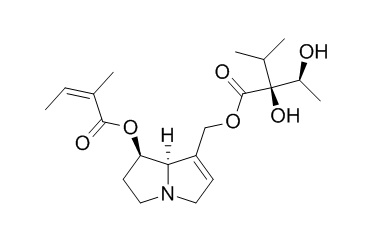Symphytine
Symphytine and senkirkine, the pyrrolizidine alkaloids, have carcinogenicity.
Inquire / Order:
manager@chemfaces.com
Technical Inquiries:
service@chemfaces.com
Tel:
+86-27-84237783
Fax:
+86-27-84254680
Address:
1 Building, No. 83, CheCheng Rd., Wuhan Economic and Technological Development Zone, Wuhan, Hubei 430056, PRC
Providing storage is as stated on the product vial and the vial is kept tightly sealed, the product can be stored for up to
24 months(2-8C).
Wherever possible, you should prepare and use solutions on the same day. However, if you need to make up stock solutions in advance, we recommend that you store the solution as aliquots in tightly sealed vials at -20C. Generally, these will be useable for up to two weeks. Before use, and prior to opening the vial we recommend that you allow your product to equilibrate to room temperature for at least 1 hour.
Need more advice on solubility, usage and handling? Please email to: service@chemfaces.com
The packaging of the product may have turned upside down during transportation, resulting in the natural compounds adhering to the neck or cap of the vial. take the vial out of its packaging and gently shake to let the compounds fall to the bottom of the vial. for liquid products, centrifuge at 200-500 RPM to gather the liquid at the bottom of the vial. try to avoid loss or contamination during handling.
Srinakharinwirot University2023, 2669.
Front Pharmacol.2024, 15:1439079.
Chinese Pharmacological Bulletin2019, 35(8):1120-1125
bioRxiv-Pharm.&Toxi.2022, 2022.481203.
J Inflamm Res.2022, 15:5347-5359.
Front Pharmacol.2021, 12:607403.
Front Immunol. 2020, 11:62.
Pharmaceuticals (Basel).2020, 13(9):262.
J Ethnopharmacol.2017, 196:75-83
J Korean Soc Food Sci Nutr2023, 52(7): 750-757
Related and Featured Products
Public Health Nutr. 2004 Oct;7(7):919-24.
Analysis of herbal teas made from the leaves of comfrey (Symphytum officinale): reduction of N-oxides results in order of magnitude increases in the measurable concentration of pyrrolizidine alkaloids.[Pubmed:
15482618]
To determine the relative quantities of two hepatotoxic pyrrolizidine alkaloids, Symphytine and echimidine, in teas prepared from comfrey leaves (Symphytum officinale), and to determine the potential contribution of the N-oxide forms of these alkaloids to levels of the parent alkaloids.
METHODS AND RESULTS:
Comfrey leaves were purchased from three commercial sources and used to prepare tea in a manner consistent with the methods used by consumers. An extraction scheme was devised for extraction of the alkaloids, and a gas chromatographic method was developed to quantify the two major alkaloids, Symphytine and echimidine. Recognising that the N-oxide derivatives of these alkaloids have also been identified in comfrey preparations, chemical reduction was applied to determine the total quantities of the alkaloids as free bases and as N-oxide derivatives.
The concentration of Symphytine and echimidine varied considerably between teas prepared from leaves purchased from the different vendors of plant material. Moreover, a much higher concentration of Symphytine was found in the tea when steps were included to reduce N-oxides prior to analysis. The treatment of pure Symphytine with hot water did not generate the N-oxide derivative de novo.
CONCLUSIONS:
Since the pyrrolizidine alkaloids are known to be hepatotoxic, consumption of herbal teas made from comfrey leaves may be ill-advised. The concentration of pyrrolizidine alkaloids in such teas may be underestimated substantially unless the concentration of N-oxides is taken into consideration.
J Natl Cancer Inst. 1979 Aug;63(2):469-72.
Induction of hepatic tumors in rats by senkirkine and symphytine.[Pubmed:
287835]
The carcinogenicity of the pyrrolizidine alkaloids senkirkine and Symphytine was studied in male inbred ACI rats.
METHODS AND RESULTS:
Animals were divided into 3 groups: Group I received ip injections of freshly prepared senkirkine at a dose of 10% of the median lethal dose (LD50) twice weekly for 4 weeks and then once a week for 52 weeks. Group II received ip injections of Symphytine at a dose of 10% of the LD50 by the same injection schedule as in group I. The control group was given ip injections of a 0.9% NaCl solution following the same injection schedule as in experimental groups. All group I rats survived for more than 290 days after the start of injections, and 9 of 20 rats developed liver cell adenoma. All group II animals survived for more than 330 days after the start of injections.
CONCLUSIONS:
Of 20 rats, 4 had liver tumors, 3 had hemangioendothelial sarcomas, and 1 had liver cell adenoma. The hemangioendothelial sarcomas showed metastasis in the lungs of 2 rats. The control group had no liver tumors.



